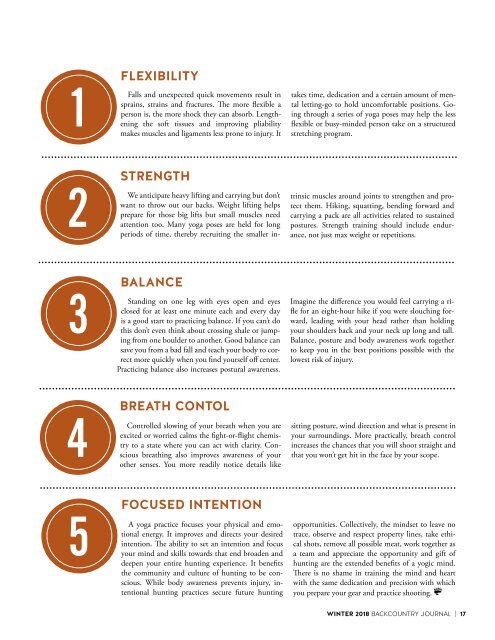BCJ_WINTER18 Digital Edition
Create successful ePaper yourself
Turn your PDF publications into a flip-book with our unique Google optimized e-Paper software.
1<br />
FLEXIBILITY<br />
Falls and unexpected quick movements result in<br />
sprains, strains and fractures. The more flexible a<br />
person is, the more shock they can absorb. Lengthening<br />
the soft tissues and improving pliability<br />
makes muscles and ligaments less prone to injury. It<br />
takes time, dedication and a certain amount of mental<br />
letting-go to hold uncomfortable positions. Going<br />
through a series of yoga poses may help the less<br />
flexible or busy-minded person take on a structured<br />
stretching program.<br />
2<br />
STRENGTH<br />
We anticipate heavy lifting and carrying but don’t<br />
want to throw out our backs. Weight lifting helps<br />
prepare for those big lifts but small muscles need<br />
attention too. Many yoga poses are held for long<br />
periods of time, thereby recruiting the smaller intrinsic<br />
muscles around joints to strengthen and protect<br />
them. Hiking, squatting, bending forward and<br />
carrying a pack are all activities related to sustained<br />
postures. Strength training should include endurance,<br />
not just max weight or repetitions.<br />
3<br />
BALANCE<br />
Standing on one leg with eyes open and eyes<br />
closed for at least one minute each and every day<br />
is a good start to practicing balance. If you can’t do<br />
this don’t even think about crossing shale or jumping<br />
from one boulder to another. Good balance can<br />
save you from a bad fall and teach your body to correct<br />
more quickly when you find yourself off center.<br />
Practicing balance also increases postural awareness.<br />
Imagine the difference you would feel carrying a rifle<br />
for an eight-hour hike if you were slouching forward,<br />
leading with your head rather than holding<br />
your shoulders back and your neck up long and tall.<br />
Balance, posture and body awareness work together<br />
to keep you in the best positions possible with the<br />
lowest risk of injury.<br />
4<br />
BREATH CONTOL<br />
Controlled slowing of your breath when you are<br />
excited or worried calms the fight-or-flight chemistry<br />
to a state where you can act with clarity. Conscious<br />
breathing also improves awareness of your<br />
other senses. You more readily notice details like<br />
sitting posture, wind direction and what is present in<br />
your surroundings. More practically, breath control<br />
increases the chances that you will shoot straight and<br />
that you won’t get hit in the face by your scope.<br />
5<br />
FOCUSED INTENTION<br />
A yoga practice focuses your physical and emotional<br />
energy. It improves and directs your desired<br />
intention. The ability to set an intention and focus<br />
your mind and skills towards that end broaden and<br />
deepen your entire hunting experience. It benefits<br />
the community and culture of hunting to be conscious.<br />
While body awareness prevents injury, intentional<br />
hunting practices secure future hunting<br />
opportunities. Collectively, the mindset to leave no<br />
trace, observe and respect property lines, take ethical<br />
shots, remove all possible meat, work together as<br />
a team and appreciate the opportunity and gift of<br />
hunting are the extended benefits of a yogic mind.<br />
There is no shame in training the mind and heart<br />
with the same dedication and precision with which<br />
you prepare your gear and practice shooting.<br />
WINTER 2018 BACKCOUNTRY JOURNAL | 17









